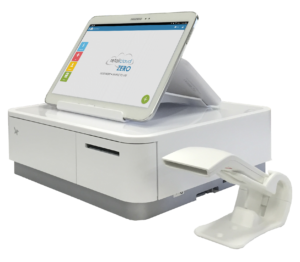With the dropping prices of hardware , many small and mid-sized retailers are adopting point of sale applications for the first time; either because they are moving from an old cash register or they are just starting their business.
This post is to help such users select the right software solution, Amazon has changed the distribution of hardware where you can buy the solution pictured above for under 400 dollars and add your own tablet for a couple of hundred more.
EVERYDAY RETAIL POS FEATURES
Here are 10 traits that are important in selecting a retail solution
- Easy for cashiers to use and understand
- Ability to Track Sales & Inventory
- Accept Cash,Credit, Gift card, NFC (Apple Pay/Android Pay) and EMV transactions
- Customer Database (CRM) to track customer activity
- Unlimited Discounts, Coupons & Promotions
- Email Marketing and Accounting integration
- Flexible Tax rates
- Barcode label printing
- Time and Attendance
- Loyalty Programs
Other things to consider are month to month contracts, freedom of payment processor, ability to connect an e-commerce for local SEO purposes.
In my next post I will write about how to best implement a POS solution, and the importance of not taking any shortcuts in implementation.
5 QUESTIONS TO ASK
I will leave you with the 5 most important questions to ask in your decision making process after you have understood what features are available.
Are there any contracts and cancellation fees?
I am always surprised how many retailers unknowingly sign up for long term year contracts just to get $600 in free equipment, like the phone contracts from the past if your hardware becomes obsolete you are still obligated to upgrade it and maintain it. Look at hardware like the Star mPOP on Amazon that you can purchase for under 400 dollars and pair it with a 10″ Amazon fire table for about 225.
How is cost of inventory calculated?
Retailers are frequently surprised to find out that many solutions track cost based on your last purchase not based on any accounting principles. Understand how this is done with any solution you are considering so that you don’t have any surprises when filing your taxes.
Is support included?
What type of support is included, and can you live with it. Many solutions are up front cost solutions and you have to pay for support on an ongoing basis. Most SaaS solutions include support in the monthly fees.
Are updates included?
Take a look at the updates that are provided, is it more than bug fixes? Do you get enhancements and features to help you compete in the marketplace. Many times I see solutions that provide new features to new customers, but require existing customers to pay for those features as there is no easy way to upgrade software for them. Understand how upgrades happen.
How much is it, and what else am I committing to?
What are the software and hardware costs, and what OS can I use. Merchant processing providers are offering to provide you free hardware and or software, find out what that means. And while these can be great offers, I have heard of many companies that have fees that kick in if you don’t do a minimum amount of credit card processing volume. Make sue you understand what this is and as I said earlier, it may be more efficient to just buy the hardware, like you did with the new phone you bought.
Jordan @ retailcloud
Latest posts by Jordan @ retailcloud (see all)
- Retail Math for SMB Retail - July 29, 2016
- How to Set Up your New POS - July 29, 2016
- Selecting the Best Point of Sale Solution for You - July 27, 2016





